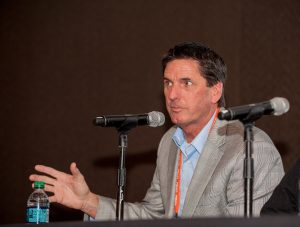Sports Venue Production Summit: Tech Vendors Address Signal Distribution
Fiber offers both challenges, benefits; at-home production is a significant trend
Story Highlights
As sports venues invest in video-display technology and the top tools to capture content, so too must they invest in the infrastructure to get video signals from Point A to Point B and beyond. At the SVG Sports Venue Production Summit at Mercedes-Benz Stadium in Atlanta earlier this month, a panel of technology vendors addressed the greatest challenges and latest developments in signal distribution — both within the stadium and from the truck dock to the broadcast center.
When It Comes to Fiber, No Two Stadiums Are the Same
As remote productions at stadium rely more and more on fiber, venues are increasingly asked to implement new fiber infrastructure to support them. Although many recently built or renovated venues boast significant fiber installations, the majority of stadiums do not, forcing broadcasters and remote-facilities providers to pull significantly more fiber strands for individual shows.

The Latest in Venue Signal Transmission and Distribution panel: (from left) Aspera’s Mike Flathers, Bexel’s Scott Nardelli, and Riedel Communications’ Rick Seegull
“One of the biggest challenges coming into a venue is fiber [infrastructure],” said Rick Seegull, manager, system consulting, Riedel Communications. “We try to move as many signals today over fiber as possible, and the biggest thing is figuring out what type of fiber topology we are dealing with when we walk into a venue. Is it a new venue? Are they able to pull new fibers? What do we have to deal with in term of existing fiber topology?”
Sharing the Fiber Wealth With Broadcasters Has Its Pros, Cons
As the latest sports venues become broadcast centers themselves with comprehensive IPTV and video-distribution capabilities, broadcasters are looking for new ways to utilize their infrastructure to benefit both parties. However, when the needs of remote productions are built into a new stadium, the venue also risks having to troubleshoot issues by opening up its production ecosystem to broadcasters and potentially having to troubleshoot signal-distribution issues down the road.
“I think, in the newer facilities, what has become an interesting opportunity is to look at how you share pathways and fiber capacity through all of the different aspects that are running in a venue – whether it’s IPTV, broadcast, ENG, radio, POS systems, security systems, or league-owned systems,” said Scott Nardelli, VP/GM, Bexel ESS. “You have to build that diversity into your facility to be able to handle those things, and I think [fiber] gives you a great opportunity to do that. But you have to balance that with [the need for] discrete end-to-end signals [to prevent] glitches introduced by air gaps and things like that.”
For New Venues, the IP Future Is Now, But Challenges Remain
Potential signal-distribution glitches will only become more of a concern as venues move toward an IP infrastructure that, instead of I/O simplicity, offers an ultra-complex decentralized network of IP addresses.

The Latest in Venue Signal Transmission and Distribution panel included input from LiveU’s Dave Belding.
“I think one of the big challenges with everything moving to IP … is the whole plethora of IP-based devices that we have and the ability to register those, discover those, and manage those,” opined Mike Flathers, CTO, Aspera (an IBM Company). “[That will] start to become a bit unwieldy, especially as you start looking at some of those devices’ actually being connected to the outside world as well.”
He stressed the importance of interoperability and the need for standards to allow that interoperability as the industry heads into this great IP frontier.
“Standards are sorely needed for these types of things,” he explained, “and there are some things coming up within both SMPTE and others to allow these devices to work together. It’s not just good enough for us to have a single vendor that provides everything; we’ve got to be able to interoperate with each other. I think there are some ways, with deep-packet-inspection technologies, to actually discover these devices as they are coming online and see what kind of streams they’re producing and then also to have devices communicating both inside the venue and outside the venue.”
The Growth of At-Home Production and Its Promise
The rise of the at-home production model has arguably been the most significant trend in live sports production over the past five years. Many broadcasters and live-streaming outlets are looking to cut costs while maintaining production quality by transmitting signals to their central control room rather than deploying a full truck and crew onsite. These at-home workflows have typically required extensive fiber or satellite connectivity, but the rise of IP transmission offers new opportunities for the approach — especially at venues with limited connectivity, such as golf courses.
“The University of Oklahoma has done two golf tournaments with eight camera operators and eight [LiveU bonded-cellular] backpacks on the golf course,” noted Dave Belding, sales director, sports, LiveU. “Everything else was done at the SoonerVision [on-campus control room]. Has anyone done a golf tournament without running a single cable? That’s exactly what they’re doing, which is the beauty of it.”
